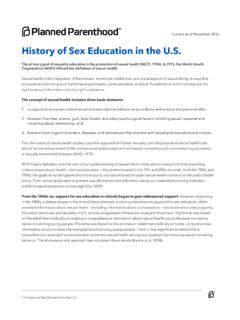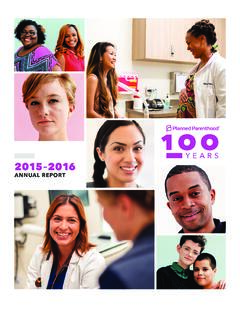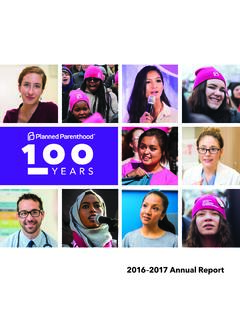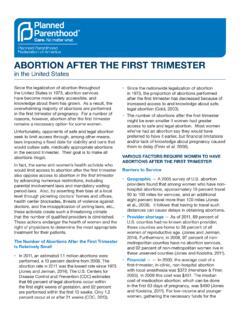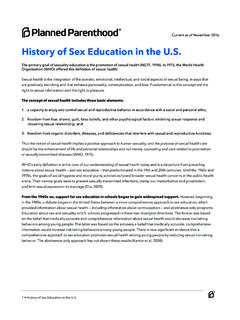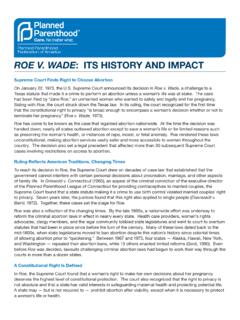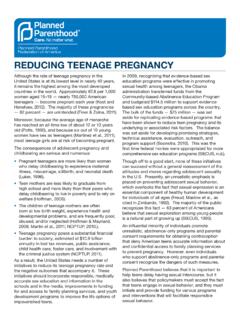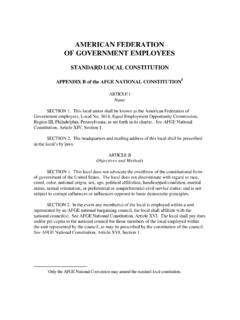Transcription of The Birth Control Pill A History - Planned Parenthood
1 Birth Control History of the pill 1In the middle of the 20th century, an age-old quest for safe and effective oral contraception was realized. The woman who made that happen was Margaret Sanger (1879 1966), the founder of the American Birth Control League, the fore-runner of Planned Parenthood Federation of America (Chesler, 1992). Planned Parenthood has played and continues to play a central role in making safe and effective family planning, including the pill , available to women and men around the world: from 1916, when Margaret Sanger opened the first Birth Control clinic in America to 1950, when Planned Parenthood underwrote the initial search for a superlative oral contraceptive to 1952 when Planned Parenthood helped found the International Planned Parenthood Federation to 1965, when Planned Parenthood of Connecticut won the Supreme Court victory, Griswold v.
2 Connecticut (Griswold), that finally and completely rolled back state and local laws that had outlawed the use of contraception by married couples to today, when Planned Parenthood continues leading the family planning movement by successfully defending and expanding women s reproductive rights and options against those who would diminish them (Chesler, 1992; Feldt & Knowles, 2002).Margaret Sanger s BrainchildIn her 70s, and years after most people retire, Sanger achieved one of the greatest accom-plishments of her career. As honorary president and chair of Planned Parenthood Federation of America, she drove the research and develop-ment of the century s most revolutionary medical breakthrough after penicillin the pill .
3 Sanger had won for most women in the the right to use contraception. Now she would develop a method that was nearly 100 percent effective. The Birth Control pill A History2 Birth Control History of the PillKatharine Dexter McCormick (1875 1967)In the 1940s and 1950s, Sanger closely followed scientific research on Birth Control and person-ally funded some of it. Planned Parenthood Federation of America also made support for new Birth Control technology a major focus of its advocacy efforts. The turning point came when Sanger s longtime friend Katharine Dexter McCormick threw her financial support behind research to produce an oral contraceptive (Chesler, 1992).
4 McCormick was Sanger s closest collaborator during her career. She was an avid crusader for women s rights, had been a leader in the suffrage movement (Fields, 2003), had helped establish the League of Women Voters (Fields, 2003), and was the second woman to graduate from the Massachusetts Institute of Technology (Fields, 2003), where she studied biology. McCormick was also heir to the International Harvester fortune. In 1950, following the death of her husband, Stanley, McCormick wrote to Sanger to ask how she could use her inheritance to contribute to contraceptive research (Chesler, 1992). This helped Sanger shift her search for an oral contraceptive into high gear during 1951 (Chesler, 1992).
5 In 1953, Sanger took McCormick on a personal visit to the Worcester Foundation for Exper-imental Biology in Massachusetts, where research scientists Gregory Pincus and Min Chueh Chang were conducting experiments that Sanger considered promising at her behest, they were trying to produce an oral contracep-tive based on synthetic progesterone. Inspired by the visit, McCormick also in her 70s used her scientific knowledge to watch over the research process. As Gregory Pincus said, she knew the field (Fields, 2003). And she used her inheritance to supply the financial backing that was so desperately first pledged $10,000 toward the research.
6 Soon after, she began contributing $150,000 to $180,000 a year, funneling a portion of the money through Planned Parenthood s research grant program. ( Planned Parenthood had supported Pincus early studies on mamma-lian eggs that led him to the work he would do on the development of the pill .) The total of McCormick s gifts to the research was $2 million, which would be more than $18 million in today s dollars (Asbell, 1995; Chesler, 1992; Grimes, 2000).All in all, McCormick donated the lion s share of the financial resources needed for the research that enabled the fulfillment of the dream she shared with Sanger making Birth Control safe, dependable, affordable, and controlled by women (Chesler, 1992).
7 The efforts to develop an oral contracep-tive would have been for naught, however, if it hadn t been for the medical folk traditions of the descendants of the Aztecs. The basic research for the pill became possible when Russell Marker discovered that generations of Mexican women had been eating a certain wild yam the Barbasco root, also called cabeza de negro for contraception (Asbell, 1995). It was from these yams that Marker was able to extract the progestin that Gregory Pincus combined with estrogen to formulate the first Birth Control pill (Grimes, 2000).Dr. John Rock (1890 1984)McCormick also funded the first clinical trials of the pill , which were conducted by Dr.
8 John Rock, an eminent gynecologist and a Roman Catholic, with patients in his private practice. Rock, who came to be regarded as a co-devel-oper of the pill , worked with Planned Parenthood staff on a closely reasoned book, The Time Has Come: A Catholic Doctor s Proposals to End the Battle over Birth Control , in which he argued Birth Control History of the pill 3unsuccessfully that the Catholic church should accept the oral contraceptive as a natural exten-sion of the rhythm method (Chesler, 1992).But distributing contraceptives or information about contraceptives was illegal in Massachu-setts, so Rock had to find another venue for wider clinical trials, or pay a $1,000 fine each time he or one of his staff gave a contraceptive or contraceptive advice to one of the women in the trial (or spend five years in prison) (Marks, 2001).
9 Holding yearlong, large-scale trials in other states where contraception was legal was also challenging because, after World War II, American women of reproductive age became highly mobile. Keeping a trial cohort together for up to three years was absolutely necessary, so less mobile populations of women were sought (M a r k s , 20 01) .After also considering Japan, Hawaii, India, Mexico, and New York, Rock and his colleagues settled on Puerto Rico as the best place to hold the trials (Marks, 2001). From the very beginning, this decision opened them to fallacious charges of racism (Tone, 2001; Marsh & Ronner, 2008).
10 In fact, they settled on Puerto Rico for several reasons: It had no laws against contraception. It had a well-established network of Birth Control clinics. It was close enough to the to allow easy visits from the research team. Many medical practitioners on the island had been trained in the , and Pincus knew and trusted them. Many of the women were semi-literate or illiterate, which allowed the researchers to test whether or not the pill could also be used by women around the world, regardless of their educational accomplishments. Puerto Rico was an island with a relatively stable population that could be followed for the full length of the trial.
